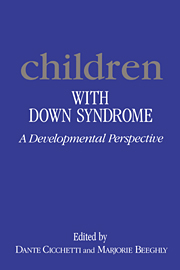Book contents
- Frontmatter
- Contents
- List of contributors
- Preface
- 1 Applying the developmental perspective to individuals with Down syndrome
- 2 An organizational approach to the study of Down syndrome: contributions to an integrative theory of development
- 3 Temperament and Down syndrome
- 4 Interactions between parents and their infants with Down syndrome
- 5 Attention, memory, and perception in infants with Down syndrome: a review and commentary
- 6 Sensorimotor development of infants with Down syndrome
- 7 The growth of self-monitoring among young children with Down syndrome
- 8 Early conceptual development of children with Down syndrome
- 9 Language abilities in children with Down syndrome: evidence for a specific syntactic delay
- 10 Beyond sensorimotor functioning: early communicative and play development of children with Down syndrome
- 11 Peer relations of children with Down syndrome
- 12 Families of children with Down syndrome: ecological contexts and characteristics
- 13 Early intervention from a developmental perspective
- Name index
- Subject index
3 - Temperament and Down syndrome
Published online by Cambridge University Press: 02 November 2009
- Frontmatter
- Contents
- List of contributors
- Preface
- 1 Applying the developmental perspective to individuals with Down syndrome
- 2 An organizational approach to the study of Down syndrome: contributions to an integrative theory of development
- 3 Temperament and Down syndrome
- 4 Interactions between parents and their infants with Down syndrome
- 5 Attention, memory, and perception in infants with Down syndrome: a review and commentary
- 6 Sensorimotor development of infants with Down syndrome
- 7 The growth of self-monitoring among young children with Down syndrome
- 8 Early conceptual development of children with Down syndrome
- 9 Language abilities in children with Down syndrome: evidence for a specific syntactic delay
- 10 Beyond sensorimotor functioning: early communicative and play development of children with Down syndrome
- 11 Peer relations of children with Down syndrome
- 12 Families of children with Down syndrome: ecological contexts and characteristics
- 13 Early intervention from a developmental perspective
- Name index
- Subject index
Summary
Temperament and Down syndrome
The characteristic manner in which individuals engage their world is typically referred to as temperament. This concept describes the approach to the world as well as the nature and affective tone of interactions that occur. In recent years, interest in temperament has been spurred by reports of the importance of understanding individual characteristics of infants and children and subsequent caretaking needs. For example, Bell's (1968) model of reciprocal influences in mother–infant interactions has underscored the importance of the infant's effect upon the mother's behavior. Additional reports by Thomas and Chess (1977, 1980) have indicated that problems in the goodness of fit between a child's characteristics and environmental demands may lead to maladaptive behavior later in life. These findings are in accord with the transactional model set forth by Sameroff and Chandler (1975), who viewed development as the product of continuous interaction between individuals and their caretaking environment. Within this theoretical framework, developmental “casualties” are poor or nonoptimal outcomes that result when the characteristics of the individual are not congruent with the expectations of the environment.
Lastly, recent research has also pointed toward the theoretical and pragmatic importance of exploring the concept of temperament. Kagan (1982; cited by Sroufe, 1985) has suggested that difficult temperament profiles in infancy may adversely affect parent–child interactions, while Cutrona and Troutman (1986) have proposed that temperament may affect parents' perceptions of self-efficacy, inducing feelings of helplessness. Additionally, researchers have also found that infant temperament is modestly related to later behavior disorders (Thomas & Chess, 1980; for a review, see Bates, 1987).
- Type
- Chapter
- Information
- Children with Down SyndromeA Developmental Perspective, pp. 63 - 100Publisher: Cambridge University PressPrint publication year: 1990
- 10
- Cited by



